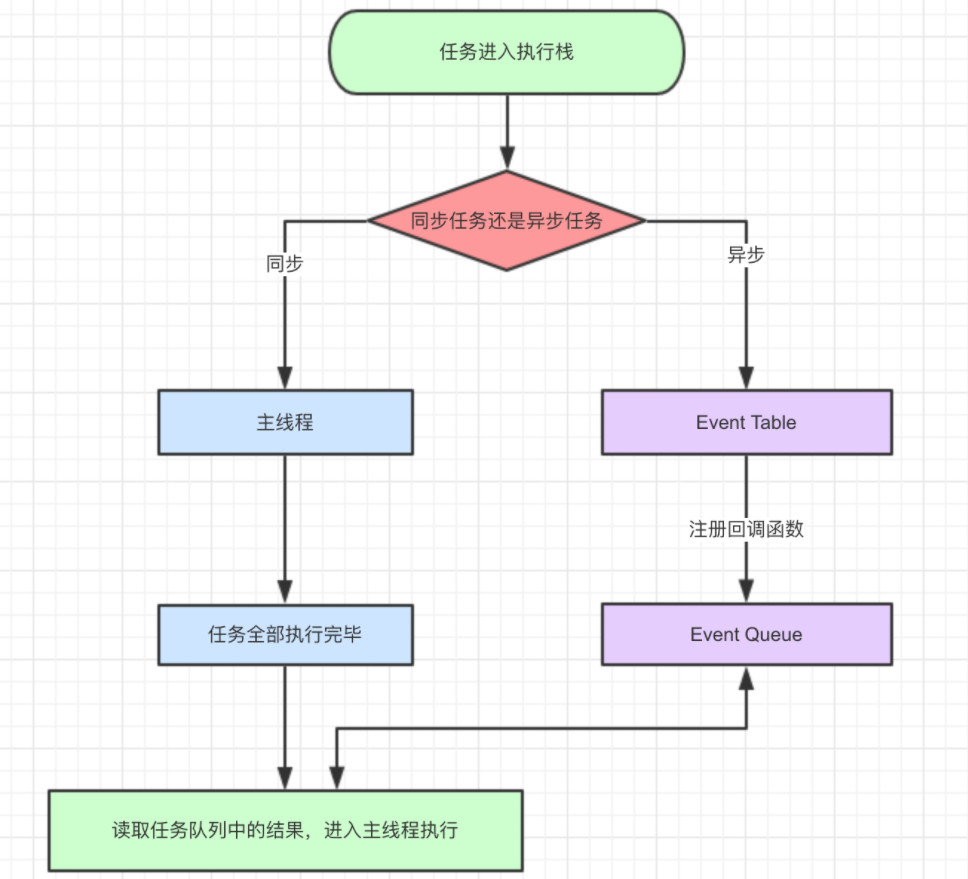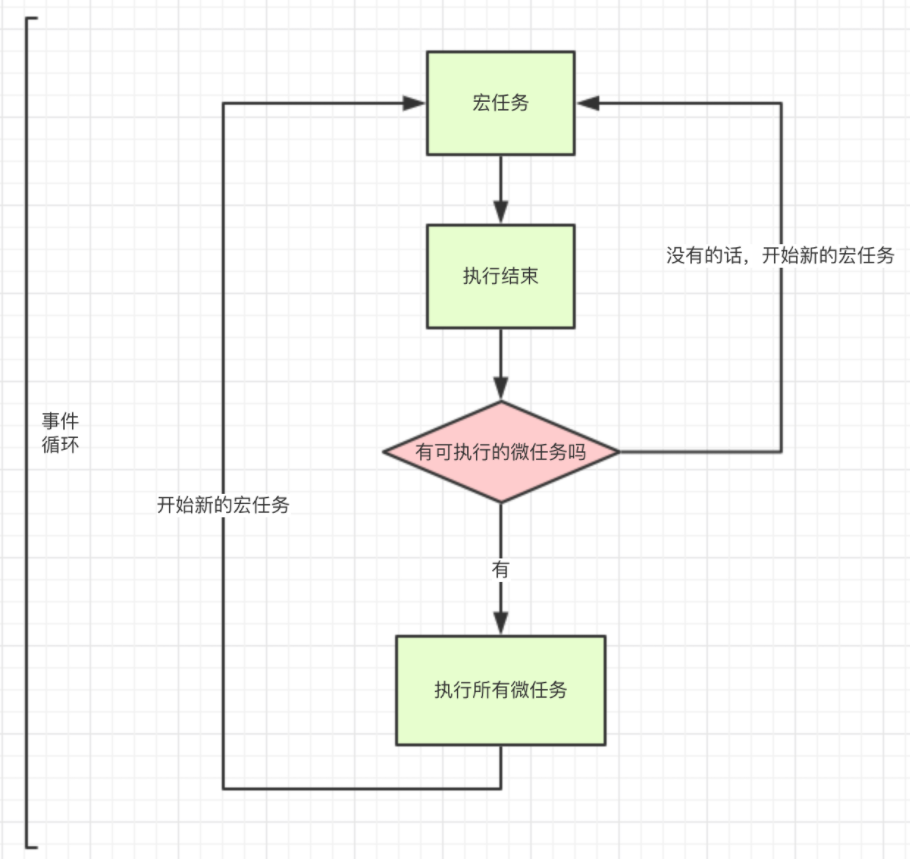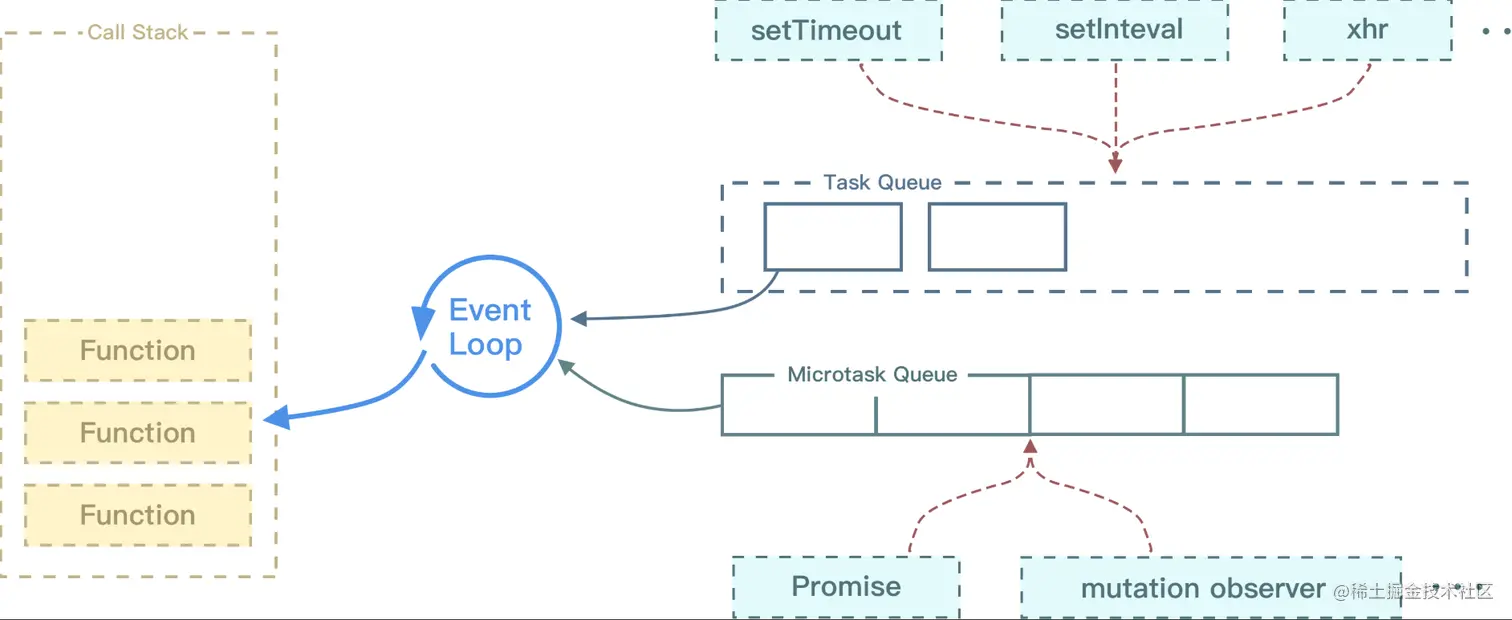单线程的 JavaScript
单线程的 JavaScript
作为浏览器脚本语言,JavaScript 的主要作用是与用户交互和操作 DOM。
如果 JavaScript 是多线程,当页面更新内容的时候,用户又触发了交互,这时候线程间的同步问题会很复杂,为了避免复杂性,JavaScript 被设计为单线程。
设计为单线程的核心原因
JavaScript 设计为单线程的原因主要与JavaScript 的运行环境(浏览器)以及它的初衷有关。
最初是为网页浏览器设计的,目的是处理用户与网页的交互,因此它的设计初衷非常强调简洁性和安全性
核心原因:
1、浏览器中的DOM操作需要简化
最初的主要用途是与HTML页面交互,尤其是操作DOM元素。由于DOM是一个共享的全局状态,如果多个线程同时操作DOM(比如同时修改元素的样式或结构),可能会导致冲突或不一致的状态
2、简化开发者的编程模型
3、历史原因和初衷
JavaScript设计之初并不是为了执行复杂的并发操作,而是处理一些简单的、基于事件的操作,如响应用户的点击、输入、表单提交等
4、异步编程引入
虽然JavaScript是单线程的,但通过异步编程模型来实现非阻塞的异步操作
5、Web Workers提供多线程支持
浏览器提供了Web Workers,允许开发者在单独的线程中运行JavaScript脚本,进行并行处理
这些线程与主线程是隔离的,因此无法直接访问DOM,也没有共享内存,减少了多线程编程中的同步问题
JavaScript 运行
JavaScript 运行时,主线程会形成一个栈,这个栈主要是解释器用来最终函数执行流的一种机制。通常这个栈被称为调用栈 Call Stack,或执行栈 Execution Context Stack
调用栈,具有后进先出的结构。
调用栈内存放的是代码执行期间的所有执行上下文。
每调用一个函数,解释器就会把该函数的执行上下文添加到调用栈并开始执行;
正在调用栈中执行的函数,如果还调用了其他函数,那么新函数也会被添加到调用栈,并立即执行;
当前函数执行完毕后,解释器会将其执行上下文清除调用栈,继续执行剩余执行上下文的剩余代码
分配的调用栈空间被占满,会引发“堆栈溢出”错误。
事件循环
单线程意味着任务需要一个一个进行,如果有任务是等待用户输入,那么在用户操作之前,其他任务都会等待,页面处于假死状态,体验很糟,所以出现了异步任务。
JavaScript 中,所有的任务都可以分为:
同步任务:立即执行的任务,同步任务一般会直接进入到主线程中执行
异步任务:异步执行的任务,比如 ajax 网络请求,setTimeout 定时函数等

异步任务又可以分为宏任务与微任务。
常见的宏任务:
script(外层同步代码)
setTimeout/setInterval
UI rendering/UI 事件
postMessage、MessageChannel
setImmediate、I/O(Node.js)
常见的微任务:
Promise.then
MutationObserver
Object.observer(已废弃,Proxy 对象替代)
process.nextTick(Node.js)
new Promise是同步任务,直接执行

async 和 await
async 用来声明一个异步方法,而 await 是用来等待异步方法执行
async 函数返回一个 promise 对象
function f() {
return Promise.resolve("TEST");
}
async function asyncF() {
return "TEST";
}正常情况下,await 命令后面是一个 Promise 对象,返回该对象的结果
如果不是 Promise 对象,就直接返回对应的值
async function f() {
return await 123;
// 等同于return 123;
}
f().then((v) => console.log(v));
// 123但不管 await 后面跟着的是什么,await 都会阻塞后面的代码
async function fn1() {
console.log(1);
await fn2();
console.log(2); //被阻塞
}
async function fn2() {
console.log("fn2");
}
fn1();
console.log(3);
// await会阻塞下面的代码,即加入微任务队列,先执行async外面的同步代码,同步代码执行完,再回到async函数中,再执行之前阻塞的代码
// 1,fn2,3,2示例:
async function async1() {
console.log("async1 start");
await async2();
console.log("async1 end");
}
async function async2() {
console.log("async2");
}
console.log("script start");
setTimeout(function () {
console.log("settimeout");
});
async1();
new Promise(function (resolve) {
console.log("promise1");
resolve();
}).then(function () {
console.log("promise2");
});
console.log("script end");
// script start、async1 start、async2、promise1、script end、async1 end、promise2、settimeoutasync/await 其他细节
async function async1 () {
await new Promise((resolve, reject) => {
resolve()
})
console.log('A')
}
async1()
new Promise((resolve) => {
console.log('B')
resolve()
}).then(() => {
console.log('C')
}).then(() => {
console.log('D')
})
// 最终结果👉: B A C D
async function async1 () {
await async2()
console.log('A')
}
async function async2 () {
return new Promise((resolve, reject) => {
resolve()
})
}
async1()
new Promise((resolve) => {
console.log('B')
resolve()
}).then(() => {
console.log('C')
}).then(() => {
console.log('D')
})
// 最终结果👉: B C D Aasync 函数处理返回值,会像 Promise.prototype.then 一样,会对返回值的类型进行辨识
👉 根据返回值的类型,引起 js 引擎 对返回值处理方式的不同
📑 结论:async 函数在抛出返回值时,会根据返回值类型开启不同数目的微任务
return 结果值:非 thenable、非 promise(不等待)
return 结果值:thenable(等待 1 个 then 的时间)
return 结果值:promise(等待 2 个 then 的时间)
async function testA () {
return 1;
}
testA().then(() => console.log(1));
Promise.resolve()
.then(() => console.log(2))
.then(() => console.log(3));
// (不等待)最终结果👉: 1 2 3
async function testB () {
return {
then (cb) {
cb();
}
};
}
testB().then(() => console.log(1));
Promise.resolve()
.then(() => console.log(2))
.then(() => console.log(3));
// (等待一个then)最终结果👉: 2 1 3
async function testC () {
return new Promise((resolve, reject) => {
resolve()
})
}
testC().then(() => console.log(1));
Promise.resolve()
.then(() => console.log(2))
.then(() => console.log(3));
// (等待两个then)最终结果👉: 2 3 1
async function testC () {
return new Promise((resolve, reject) => {
resolve()
})
}
testC().then(() => console.log(1));
Promise.resolve()
.then(() => console.log(2))
.then(() => console.log(3))
.then(() => console.log(4))
// (等待两个then)最终结果👉: 2 3 1 4async function async1 () {
console.log('1')
await async2()
console.log('AAA')
}
async function async2 () {
console.log('3')
return new Promise((resolve, reject) => {
resolve()
console.log('4')
})
}
console.log('5')
setTimeout(() => {
console.log('6')
}, 0);
async1()
new Promise((resolve) => {
console.log('7')
resolve()
}).then(() => {
console.log('8')
}).then(() => {
console.log('9')
}).then(() => {
console.log('10')
})
console.log('11')
// 最终结果👉: 5 1 3 4 7 11 8 9 AAA 10 6跟 Promise 的情况
async function test () {
console.log(1);
await new Promise((resolve, reject) => {
resolve()
})
console.log(2);
}
test();
console.log(3);
Promise.resolve()
.then(() => console.log(4))
.then(() => console.log(5))
.then(() => console.log(6))
.then(() => console.log(7));
// 最终结果👉: 1 3 2 4 5 6 7
// 为什么不等待两个 then 的时间呢?
// TC 39(ECMAScript标准制定者) 对await 后面是 promise 的情况如何处理进行了一次修改,移除了额外的两个微任务,在早期版本,依然会等待两个 then 的时间
// 但在这次更新中并没有修改 thenable 的情况
// 这样做可以极大的优化 await 等待的速度事件循环
JavaScript 代码的执行过程中,除了依靠函数调用栈来搞定函数的执行顺序外,还依靠任务队列(task queue)来搞定另外一些代码的执行。整个执行过程,我们称为事件循环过程。一个线程中,事件循环是唯一的,但是任务队列可以拥有多个。任务队列又分为 macro-task(宏任务)与 micro-task(微任务),在最新标准中,它们被分别称为 task 与 jobs。
执行顺序:
执行同步代码
执行完所有同步代码后且执行栈为空,判断是否有微任务需要执行
执行所有微任务且微任务队列为空
是否有必要渲染页面
执行一个宏任务macro-task 大概包括:
script(整体代码,可以理解为外层同步代码)
setTimeout
setInterval
setImmediate
I/O
UI render
micro-task 大概包括:
process.nextTick
Promise
Async/Await(实际就是 promise)
MutationObserver(html5 新特性)

